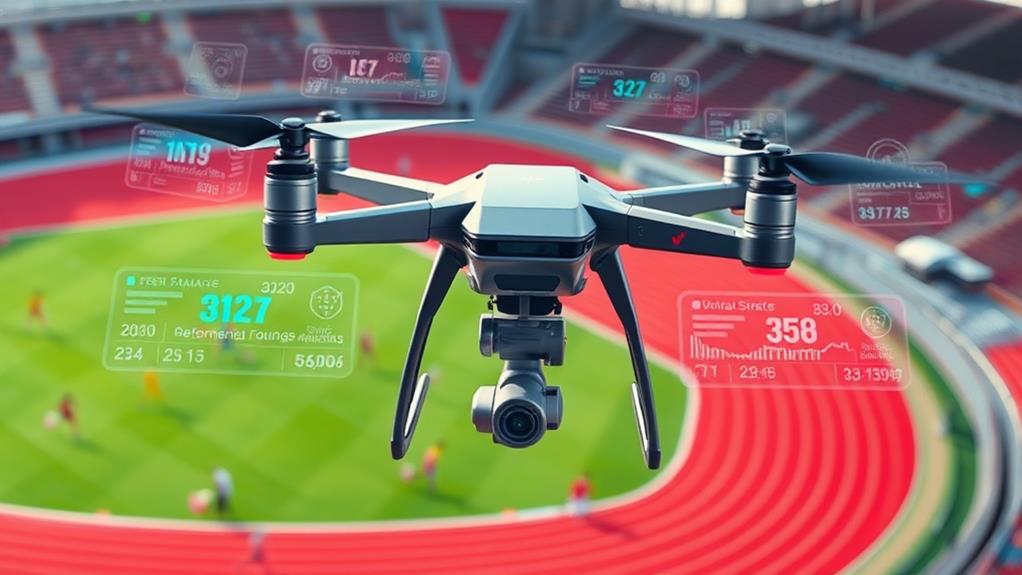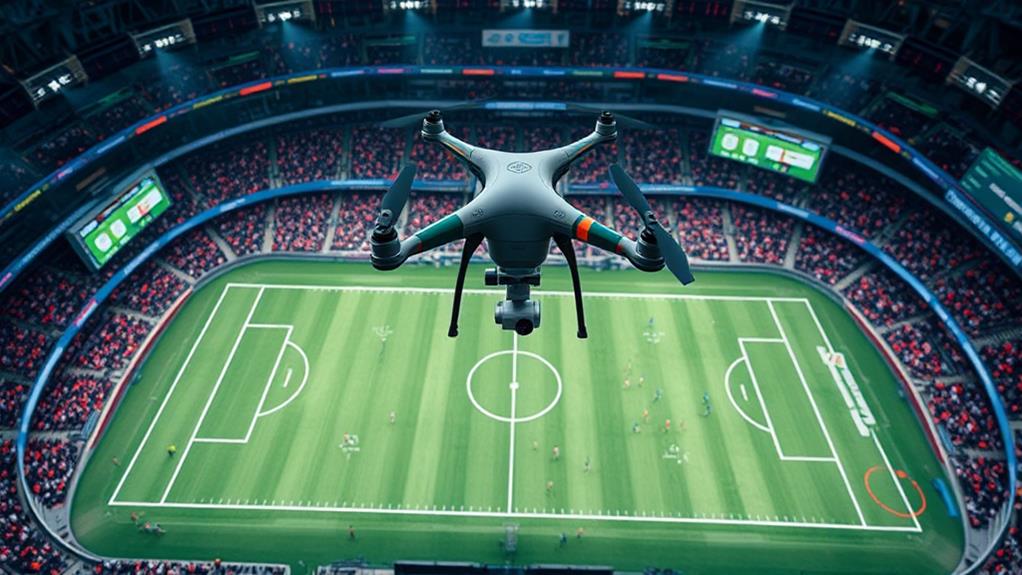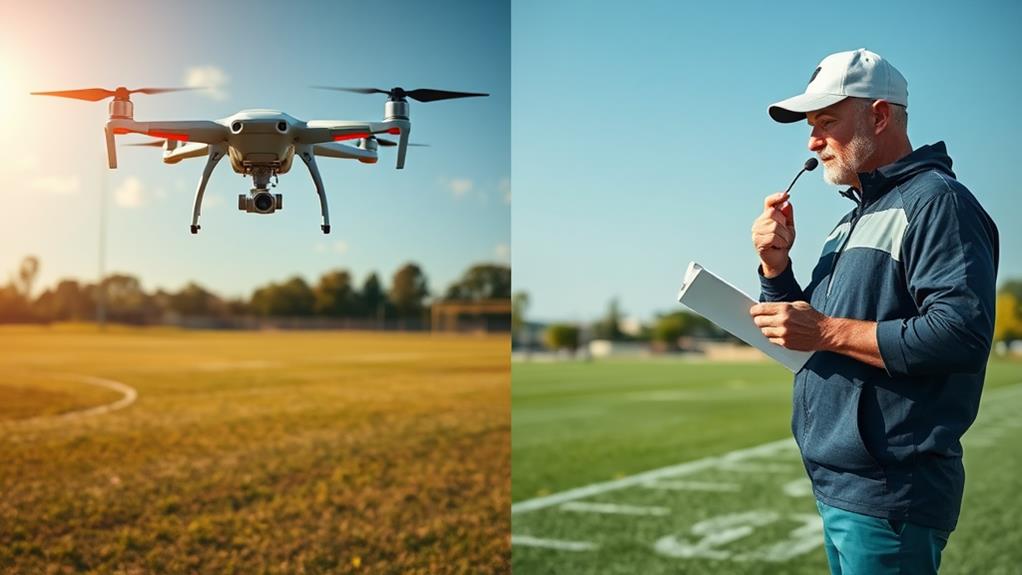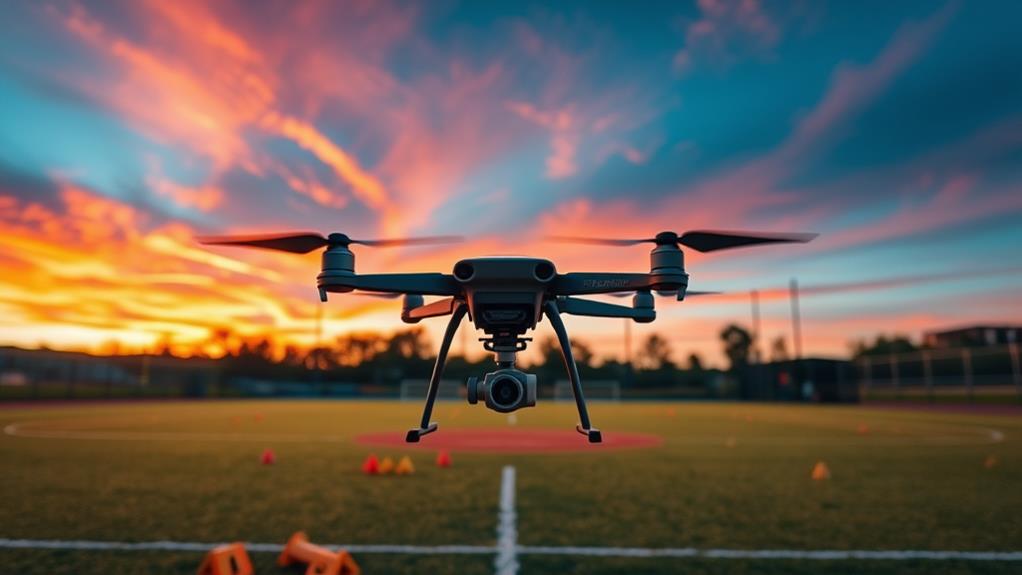Drones are revolutionizing sports training by offering unique aerial perspectives that enhance performance analysis and coaching strategies. You'll find that these devices provide real-time data that allows coaches to make immediate adjustments during practice. With detailed footage, drones capture player movements and positioning, leading to personalized feedback. This technology improves teamwork and communication, giving athletes a thorough understanding of their dynamics. Compared to traditional ground-based methods, drones enhance strategic development and decision-making. Teams like the Miami Hurricanes utilize drones for peak training, highlighting their impact. There's much more to explore about these advancements in sports technology that could benefit you.
Overview of Drone Technology in Sports

Drones have taken sports training to new heights, offering coaches and athletes a unique perspective on performance. By integrating drone technology into training sessions, teams can enhance their strategic formations and improve spatial awareness.
Imagine watching your practice from above, where you can see how players interact in real-time. This bird's-eye view allows for a deeper understanding of team dynamics and individual positioning. With advancements in drone technology basics, such as enhanced battery efficiency and GPS integration, drones can provide more reliable and detailed data collection during training.
Coaches utilize drone footage for detailed performance analysis, giving personalized feedback that targets specific skill improvements. For instance, in sports like soccer and tennis, drones capture thorough positional data, which leads to more accurate performance reviews. This data-driven approach is transforming how coaches develop training methodologies.
Professional teams like the Miami Hurricanes and Everton FC have already adopted this innovative technology, showcasing its effectiveness in refining coaching strategies. Drones represent a significant shift in sports training paradigms, allowing athletes to gain insights that were previously inaccessible.
As you engage in your training sessions, consider how this technology could elevate your performance and help you reach your goals. The future of sports training is here, and it's taking flight with drones.
Aerial Perspectives for Performance Analysis
With the integration of aerial perspectives in performance analysis, coaches can now gain unparalleled insights into player dynamics. Drones provide thorough views that enhance strategic formation and spatial awareness during sports training.
You'll see how this technology allows coaches to assess player positioning more effectively, leading to significant improvements.
Consider these benefits of aerial perspectives in performance analysis:
- Detailed Footage: Coaches can capture specific moments during training sessions for personalized feedback.
- Positional Data: Drones collect data on player positioning in various sports, like soccer and tennis, enhancing tactical planning.
- Enhanced Team Dynamics: Insights into player movements and interactions foster better teamwork and communication.
- Holistic View: Drone footage offers a complete perspective on athletic performance, surpassing traditional ground-based systems.
Integrating drones into training not only refines skills but also boosts overall player performance.
This transformative shift in sports training methodologies enables coaches to tailor strategies based on real-time data, ensuring players receive the guidance they need to excel.
With aerial perspectives, you're witnessing a revolution in how performance analysis is approached in sports.
Enhancing Coaching Strategies With Drones

Using drones in training offers you tactical insights that traditional methods can't match.
With real-time performance analysis, you can see exactly how players move and position themselves, allowing for targeted feedback and adjustments.
This aerial footage can transform coaching strategies, making them more effective and tailored to each athlete's needs.
Tactical Insights From Aerial Footage
Aerial footage transforms the way coaches analyze player performance and strategies during training sessions. By utilizing drones, you gain unique perspectives that enhance tactical insights, allowing for a thorough examination of player formations and movements.
This technology enables coaches to implement more effective strategies and make real-time adjustments, creating a dynamic training environment.
Consider these benefits of aerial footage:
- Enhanced Tactical Reviews: Teams like the Miami Hurricanes and Everton FC leverage drone footage to identify player strengths and weaknesses.
- Improved Communication: Clear visual demonstrations of tactics help bridge the gap between coaches and players, making adjustments easier to understand.
- Real-Time Strategy Adjustments: Coaches can quickly adapt their game plans based on what they observe from the aerial view.
- Refined Skill Development: Studies show that integrating drones into training leads to better performance analysis, honing athletes' skills more effectively.
When you incorporate aerial footage into your training regimen, you not only improve communication but also foster a deeper understanding of the game.
This innovative approach guarantees that each player can optimize their performance, making the most of every training session.
Real-Time Performance Analysis
The ability to analyze player performance in real-time revolutionizes coaching strategies. With drones, you gain access to thorough aerial views of training sessions, giving you a detailed perspective on player positioning and movement. This enhances your tactical decision-making, allowing for more effective game strategies.
By utilizing high-resolution drone footage, you can track real-time performance data, which helps identify strengths and weaknesses in your athletes' skills. As a coach, you can deliver personalized feedback based on the insights gained from drone analysis. This greatly improves skill development and refines strategies tailored to each player's needs.
Furthermore, integrating drones into your training regimen enhances team dynamics, as you gain insights into how players interact on the field. The ability to make real-time strategy adjustments during practice is invaluable.
Studies show that drone technology can increase performance accuracy by minimizing measurement discrepancies to as low as 2.36% compared to traditional tracking systems. In a fast-paced sports environment, having precise data at your fingertips allows for better decision-making and improved overall performance.
Embracing this innovative approach could set your team apart.
Real-Time Data for Athlete Feedback
With drones capturing real-time data on your movements, you can receive instant feedback on your performance.
This immediate analysis helps identify areas for improvement, allowing your coach to develop tailored training strategies that enhance your skills.
As a result, you not only grow as an athlete but also gain a deeper understanding of your game.
Instant Performance Analysis
Drones are revolutionizing instant performance analysis in sports training by providing real-time data that coaches and athletes can act on immediately.
With drones equipped with advanced sensors, you'll benefit from immediate feedback that sharpens your skills and enhances your understanding of game dynamics. The aerial footage captures not just individual performance but also team formations, essential for strategic development.
Here are some key benefits of using drones for instant performance analysis:
- Real-Time Data: Coaches receive immediate insights into your performance, allowing for on-the-spot adjustments.
- Aerial Footage: Thorough views of player movements help identify areas for improvement in positioning and spatial awareness.
- Frame-by-Frame Breakdown: Coaches can analyze plays in detail, providing more personalized critiques to refine your technique.
- Improved Skill Development: Regular drone usage in training has shown to enhance decision-making skills in dynamic environments.
Enhanced Training Strategies
Real-time data from drones enhances training strategies by providing athletes with immediate feedback that's specific and actionable. Drones equipped with advanced sensors capture aerial footage, allowing coaches to analyze your movements and positioning from unique angles. This perspective enriches tactical discussions during practice, fostering a deeper understanding of your performance.
With detailed performance data in hand, coaches can deliver personalized feedback tailored to your strengths and weaknesses. This precise approach helps identify areas for improvement, ensuring that your training is both efficient and effective. As you receive immediate insights, you can make rapid adjustments, paving the way for quicker skill development.
Moreover, the integration of drones boosts your spatial awareness and decision-making skills, essential for excelling in competitive settings. Sports teams utilizing drone technology have reported measurable improvements in team dynamics and strategy execution during games.
Drones in Tactical Training Sessions

In tactical training sessions, coaches gain unparalleled insights through aerial perspectives provided by drone technology. By utilizing drones, teams like the Miami Hurricanes and Everton FC can analyze player positioning and movement from various angles, enhancing strategic planning. This technology allows for detailed post-session reviews, refining tactics and improving overall performance.
Here are some key benefits of using drones in tactical training:
- Aerial Footage: Coaches can capture and review formations and spacing, which helps in making real-time adjustments to training strategies.
- Enhanced Communication: Players can visually grasp and discuss formations more effectively, improving teamwork.
- Spatial Awareness: Studies show that drone footage can boost players' spatial awareness and decision-making skills during actual gameplay.
- Strategic Insights: Coaches can observe player behavior and positioning, leading to smarter game strategies.
Incorporating drones into sports training not only enhances the tactical understanding of players but also sets a new standard for how teams prepare for competition.
With the ability to analyze training sessions from unique perspectives, drone technology is revolutionizing the approach to tactical training in sports.
Case Studies of Successful Drone Integration
Transforming training methods, various sports teams have successfully integrated drone technology into their routines, yielding impressive results. The Miami Hurricanes football team utilizes drones to capture training sessions, providing coaches with aerial insights into player formations and strategies. This approach enhances training effectiveness by allowing for a clear visualization of tactical adjustments.
Similarly, Everton FC employs drone footage during soccer training to analyze tactical plays from multiple angles. This thorough analysis aids in refining player positioning and teamwork, ultimately boosting overall performance.
The Seattle Sounders also leverage drones, monitoring practice sessions to deliver targeted feedback based on detailed aerial views of player movements.
A pilot study by Russomanno et al. (2022) demonstrated the accuracy of drones in aerial performance tracking for sports like tennis and soccer, achieving root mean square errors of only 0.02 m and 0.15 m, respectively. This level of precision further emphasizes the effectiveness of drone technology in sports training.
Additionally, the integration of drones enhances security, as they allow for remote monitoring of training environments. As various teams adopt drones, it's clear that this technology is revolutionizing sports training through improved performance analysis and enhanced team dynamics.
Comparison With Traditional Training Methods

The integration of drones not only showcases their potential in enhancing training effectiveness but also highlights significant differences compared to traditional training methods. When you consider how athletes train, drones offer a new dimension that can remarkably improve performance analysis.
- Drones provide extensive aerial perspectives, enhancing spatial awareness and strategy development.
- Unlike ground-based systems, drones enable real-time data collection, allowing coaches to make immediate adjustments.
- The accuracy of positional data captured by drones can reduce discrepancies to as low as 0.02 meters, far surpassing traditional methods.
- Coaches can analyze complex game dynamics and refine tactics, leading to a more holistic approach to athlete development.
In contrast, traditional training methods primarily rely on video footage from ground-level, which limits the depth of analysis. They often involve manual tracking, making it difficult to obtain immediate insights.
Drones, on the other hand, revolutionize this process by offering unique angles and better performance reviews. By adopting drones in training, you're not just following trends; you're embracing a more effective and insightful approach to athletic development that traditional methods simply can't match.
Future Innovations in Drone Technology
Embracing future innovations in drone technology promises to revolutionize sports training even further. Advanced drones are on the horizon, featuring autonomous operations that allow them to follow athletes seamlessly. This means you won't have to control the drone manually, letting it capture your movements effortlessly.
One of the most exciting developments is the integration of artificial intelligence, which enhances real-time data analysis. Imagine receiving immediate feedback on your performance and tactics during practice sessions. This capability will allow you to make quick adjustments to improve your skills continuously.
Additionally, eco-friendly advancements in drone technology aim to reduce carbon footprints, aligning sports training with environmental goals. Noise reduction technologies are also being researched to minimize disturbances caused by drone operations.
This enhancement will create a more focused training environment for you and your teammates. Collaborations with environmental organizations will promote sustainable practices in drone usage, ensuring their deployment in sports training is both effective and responsible.
As these innovations unfold, you can expect a more efficient, environmentally friendly, and insightful training experience that sets the stage for future athletic excellence.
Addressing Challenges and Ethical Concerns

As drones become more common in sports training, you need to take into account several challenges and ethical concerns.
Privacy issues arise when athletes and coaches face the risk of being filmed without consent during practices.
Additionally, ensuring safety compliance and evaluating the environmental impact of drone usage are essential steps in responsibly integrating this technology into training routines.
Privacy Issues in Training
In today's sports training landscape, the rise of drones brings significant privacy challenges that can't be overlooked. While drones offer advanced performance analysis, they also raise serious privacy issues, especially concerning surveillance during practice sessions and the collection of personal data by coaching staff.
It's important to navigate these challenges carefully to protect athletes' rights.
Here are some key considerations:
- Surveillance during training: Athletes might feel uncomfortable being monitored constantly.
- Data collection ethics: Who owns the data collected by drones, and how is it used?
- Consent and transparency: Athletes should be informed and agree to aerial monitoring.
- Developing regulations: Many sports organizations are still figuring out how to comply with evolving drone laws.
As the technology continues to evolve, it's imperative for sports organizations to collaborate with regulatory bodies.
Establishing clear guidelines will help prevent privacy invasions and address ethical concerns surrounding drone usage in training.
Athletes deserve the right to train without feeling like their every move is being scrutinized.
Balancing performance benefits with privacy protection is essential for maintaining trust in sports environments.
Safety Regulation Compliance
Maneuvering the complexities of safety regulation compliance is crucial when integrating drones into sports training. You need to understand that utilizing drones for aerial coverage involves adhering to specific guidelines set by regulatory bodies like the FAA. These regulations include maintaining certain altitude restrictions and making certain that drone operators keep the device within their line of sight during flights. This not only prevents accidents but also safeguards the athletes and personnel on the field.
Moreover, ethical concerns surrounding privacy must be addressed. Sports organizations are developing policies to protect the rights of athletes and spectators when using aerial footage. This guarantees that while you're capturing critical training moments, you're also respecting individual privacy.
Safety incidents, such as drone crashes during events, underscore the importance of strict operational protocols. Implementing rigorous safety measures is crucial to prevent injury or disruption during training sessions.
Collaborating with regulatory bodies can help shape responsible drone policies, making certain compliance with aviation regulations while enhancing the training experience. By prioritizing safety regulation compliance, you can harness the benefits of drone technology without compromising the safety and privacy of everyone involved.
Environmental Impact Considerations
Integrating drones into sports training not only raises safety and privacy concerns but also brings environmental impact considerations to the forefront. As you explore the use of drones, it's important to assess their ecological footprint, especially since drone operations can lead to increased energy consumption and potential disturbances to wildlife.
Here are some key considerations:
- Energy Use: Traditional drones may consume significant energy, contributing to a larger carbon footprint.
- Wildlife Disturbance: The noise and presence of drones can disrupt local ecosystems and wildlife habitats.
- Regulatory Compliance: Using drones in sensitive areas requires adherence to environmental regulations to minimize impact.
- Eco-Friendly Drones: Integrating drones that focus on sustainability and reduce carbon emissions is essential for addressing these environmental concerns.
To promote sustainable practices, collaboration with environmental organizations is imperative.
Additionally, advances in noise reduction technologies can help mitigate disturbances to wildlife during training sessions.
The Impact on Athlete Development
Over the past few years, the use of drones in sports training has revolutionized athlete development by offering unparalleled insights into performance. With aerial views during training sessions, you can analyze player positioning and movement from unique perspectives that traditional methods simply can't provide. This enhanced tactical understanding helps refine formation strategies, making you a more effective player.
Drones also improve performance analysis by capturing detailed footage that enables personalized feedback. Coaches can pinpoint areas for targeted skill refinement, which is essential for your growth as an athlete. For instance, a pilot study showed that drones can achieve a root mean square error of just 0.02 meters in tennis, vastly improving the accuracy of positional data.
Teams like the Miami Hurricanes and Everton FC have embraced drone technology, demonstrating a shift toward data-driven training methodologies. By facilitating real-time strategy adjustments, drones offer extensive field views that enhance decision-making during practice sessions.
Ultimately, this leads to improved athlete development, ensuring you have the tools and insights needed to excel in your sport. With drones, the future of training looks brighter than ever.
Conclusion
To summarize, drones are transforming sports training into a dynamic and insightful experience. By providing aerial perspectives and real-time data, they empower athletes and coaches alike to elevate performance and strategy. As you embrace this technology, remember that each flight carries the potential to refine skills and enhance teamwork, much like a conductor leading an orchestra. The future of sports training is not just on the ground; it's soaring above, ready to release new levels of achievement.

Leave a Reply